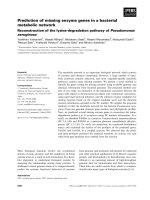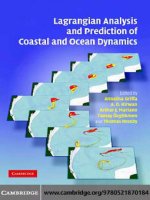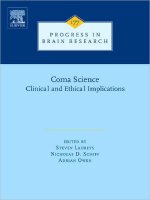Lagrangian analysis and prediction of coastal and ocean dynamics a griffa, et al , (cambridge, 2007) WW
Bạn đang xem bản rút gọn của tài liệu. Xem và tải ngay bản đầy đủ của tài liệu tại đây (16.51 MB, 525 trang )
This page intentionally left blank
LAGRANGIAN ANALYSIS AND PREDICTION
OF COASTAL AND OCEAN DYNAMICS
Written by a group of international experts in their field, this book is a review
of Lagrangian observation, analysis and assimilation methods in physical and
biological oceanography. In recent years a large number of floating and
drifting research buoys have been deployed in the global oceans to study the
state of the ocean and its variation in terms of water mass properties, circula-
tion and heat transport. Lagrangian techniques are required to analyze the
data from these buoys.
This multidisciplinary text contains observations, theory, numerical simula-
tions, and analysis techniques. It presents new results on nonlinear analysis of
Lagrangian dynamics, the prediction of particle trajectories, and Lagrangian
stochastic models. It includes chapters on floats and drifters, Lagrangian-
based analysis methods and models in marine biology, the statistics of particle
trajectories in the ocean, numerical simulations and their relationship with
classical turbulence results, and nonlinear Lagrangian-based theory for study-
ing ocean transport and particle trajectories. The book contains historical
information, up-to-date developments, and speculation on future develop-
ments in Lagrangian-based observations, analysis, and modeling of physical
and biological systems.
Containing contributions from experimentalists, theoreticians, and model-
ers in the fields of physical oceanography, marine biology, mathematics, and
meteorology this book will be of great interest to researchers and graduate
students looking for both practical applications and information on the theory
of transport and dispersion in physical systems, biological modeling, and data
assimilation.
Cover illustration: The cover depicts the abrupt breakup of a large ocean
eddy in the Gulf of Mexico. Eddy Fourchon was tracked by assimilating
satellite data into the University of Colorado version of the Princeton Ocean
Model (developed by L. H. Kantha). Lagrangian analysis by researchers at the
University of Delaware (led by A. D. Kirwan, Jr.) and the City University of
New York (A. C. Poje) produced the time sequence of marked particles in the
middle of the Gulf between July 28 and August 17, 1998. On July 28, Fourchon
appears to be a typical large elliptical ocean eddy. Over the next two and a half
weeks, interactions with nearby mesoscale features split the core in half. The
larger colored region is determined by computing the Lagrangian boundaries
of the eddy on the initial day with red/yellow assigned to those particles within
the eddy which eventually split to the north/south respectively. The contrast-
ing inscribed circles show the stirring inherent in each sub-region during the
evolution. Figure design by Patrick Fagan.
LAGRANGIAN ANALYSIS AND
PREDICTION OF COASTAL AND
OCEAN DYNAMICS
Edited by
ANNALISA GRIFFA
Rosenstiel School of Marine and Atmospheric Science
University of Miami
Istituto di Scienze Marine, Consiglio Nazionale Ricerche, La Spezia, Italy
A. D. KIRWAN, JR.
University of Delaware
ARTHUR J. MARIANO
Rosenstiel School of Marine and Atmospheric Science
University of Miami
TAMAY M.
¨
OZG
¨
OKMEN
Rosenstiel School of Marine and Atmospheric Science
University of Miami
THOMAS ROSSBY
Graduate School of Oceanography
University of Rhode Island
CAMBRIDGE UNIVERSITY PRESS
Cambridge, New York, Melbourne, Madrid, Cape Town, Singapore, São Paulo
Cambridge University Press
The Edinburgh Building, Cambridge CB2 8RU, UK
First published in print format
ISBN-13 978-0-521-87018-4
ISBN-13 978-0-511-27414-5
© Cambridge University Press 2007
2007
Information on this title: www.cambrid
g
e.or
g
/9780521870184
This publication is in copyright. Subject to statutory exception and to the provision of
relevant collective licensing agreements, no reproduction of any part may take place
without the written permission of Cambridge University Press.
ISBN-10 0-511-27414-9
ISBN-10 0-521-87018-6
Cambridge University Press has no responsibility for the persistence or accuracy of urls
for external or third-party internet websites referred to in this publication, and does not
guarantee that any content on such websites is, or will remain, accurate or appropriate.
Published in the United States of America by Cambridge University Press, New York
www.cambridge.org
hardback
eBook (EBL)
eBook (EBL)
hardback
Contents
List of contributors page vi
Preface xi
1 Evolution of Lagrangian methods in oceanography 1
2 Measuring surface currents with Surface Velocity Program
drifters: the instrument, its data, and some recent results 39
3 Favorite trajectories 68
4 Particle motion in a sea of eddies 89
5 Inertial particle dynamics on the rotating Earth 119
6 Predictability of Lagrangian motion in the upper ocean 136
7 Lagrangian data assimilation in ocean general
circulation models 172
8 Dynamic consistency and Lagrangian data in
oceanography: mapping, assimilation, and optimization schemes 204
9 Observing turbulence regimes and Lagrangian dispersal
properties in the oceans 231
10 Lagrangian biophysical dynamics 275
11 Plankton: Lagrangian inhabitants of the sea 349
12 A Lagrangian stochastic model for the dynamics of a stage
structured population. Application to a copepod population 401
13 Lagrangian analysis and prediction of coastal and ocean
dynamics (LAPCOD) 423
Index 480
The color plates are situated between pages 228 and 229.
v
Contributors
Amy S Bower
Department of Physical
Oceanography
Woods Hole Oceanographic Institute
Woods Hole, MA 02543
USA
Annalisa Bracco
Department of Physical
Oceanography
Woods Hole Oceanographic
Institution
Woods Hole, MA 02543
USA
Giuseppe Buffoni
ENEA
Santa Teresa – Lerici
La Spezia I-19100
Italy
Jim Carton
University of Maryland
Stadium Drive
College Park, MD 20742-0001
USA
Luca R Centurioni
Scripps Institute of Oceanography
9500 Gilman Drive
La Jolla, CA 92093-0213
USA
Toshio Chin
RSMAS/MPO
University of Miami
4600 Rickenbacker Causeway
Miami, FL 33149
USA
Curtis A Collins
Code Oc/Co
Department of Oceanography
Naval Postgraduate School
833 Dyer Road
Monterey, CA 93943-5122
USA
Robert K Cowen
RSMAS/MBF
University of Miami
4600 Rickenbacker Causeway
Miami, FL 33149
USA
vi
Heather Furey
Department of Physical
Oceanography
Woods Hole Oceanographic Institute
Woods Hole, MA 02543
USA
Newell Garfield
San Francisco State University
Geosciences Dept.
3152 Paradise Drive
Tiburon, CA 94920
USA
Annalisa Griffa
RSMAS/MPO
University of Miami
4600 Rickenbacker Causeway
Miami, FL 33149
USA
ISMAR/CNR
Forte Santa Teresa
La Spezia I-19036
Italy
Semyon Grodsky
Department of Meteorology
University of Maryland
College Park, MD 20742
USA
Gary L Hitchcock
RSMAS/MBF
University of Miami
4600 Rickenbacker Causeway
Miami, FL 33149
USA
Kayo Ide
Institute of Geophysics & Planetary
Physics
UCLA
Los Angeles, CA 90095-1567
USA
Christopher Jones
University of North Carolina at
Chapel Hill
CB #32350
UNC-CH
Chapel Hill, NC 27599
USA
YooYin Kim
Scripps Institute of Oceanography
9500 Gilman Drive
La Jolla, CA 92093-0213
USA
Vassiliki Kourafalou
RSMAS/MPO
University of Miami
4600 Rickenbacker Causeway
Miami, FL 33149
USA
Leonid Kuznetsov
Applied Mathematics
University of North Carolina at
Chapel Hill
(Phillips Hall 362)
Chapel Hill, NC 27599
USA
List of contributors vii
Matthias Lankhorst
Leibniz-Institut fur
Meereswissenschaften
(IFM-GEOMAR)
Dusternbrooker Weg 20
Kiel D-24105
Germany
Dong-Kyu Lee
Department of Marine Sciences
Busan National University
Busan 609-735
South Korea
Thomas N Lee
RSMAS/MPO
University of Miami
4600 Rickenbacker Causeway
Miami, FL 33149
USA
Rick Lumpkin
Atlantic Oceanographic &
Meteorological Lab
NOAA/AOML/PhOD
4301 Rickenbacker Causeway
Miami, FL 33149
USA
Svend-Aage Malmberg
Marine Research Institute
1 Hafrannsoknansofnunin
PO Box 1390
Skulgata 4
Reykjavik 121
Iceland
Arthur J Mariano
RSMAS/MPO
University of Miami
4600 Rickenbacker Causeway
Miami, FL 33149
USA
Maria Grazia Mazzocchi
Stazione Zoologica A. Dohrn
Villa Communale
Napoli I-80121
Italy
Anne Molcard
LSEET
University of Toulon
Forte Santa Teresa
La Spezia I-19036
Italy
Pearn P Niiler
Scripps Institute of Oceanography
9500 Gilman Drive
La Jolla, CA 92093-0213
USA
Donald B Olson
RSMAS/MPO
University of Miami
4600 Rickenbacker Causeway
Miami, FL 33149
USA
Tamay O
¨
zgo
¨
kmen
RSMAS/MPO
University of Miami
4600 Rickenbacker Causeway
Miami, FL 33149
USA
viii List of contributors
Nathan Paldor
Hebrew University of Jerusalem
Institute of Earth Sciences
Edmund Safra Campus, Givat Ram
Jerusalem 92509
Israel
Sara Pasquali
CNR-IMATI
via Bassini, 15
Milano I-20133
Italy
Claudia Pasquero
Earth System Science Dept.
University of California
3224 Croul Hall
Irvine, CA 92697-3100
USA
Mayra C Pazos
Atlantic Oceanographic &
Meteorological Lab
NOAA/AOML/PhOD
4301 Rickenbacker Causeway
Miami, FL 33149
USA
Leonid Piterbarg
University of Southern California
Kaprielian Hall, Room 108
3620 Vermont Avenue
Los Angeles, CA 90089-2532
USA
Pierre-Marie Poulain
Istituto Nazionale di Oceanografia e
di Geofisica
Sperimentale (OGS)
Borgo Grotta Gigante 42/c
Trieste I-34010
Italy
Antonello Provenzale
Institute of Atmospheric Sciences &
Climate
CNR
Corso Fiume, 4
Torino I-10133
Italy
Thomas A Rago
Department of Oceanography
Naval Postgraduate School
833 Dyer Road, Rm 328
Monterey, CA 93943
USA
Thomas Rossby
University of Rhode Island
Graduate School of Oceanography
Kingston, RI 02881
USA
Volfango Rupolo
ENEA
via Anguillarese, 301
Roma I-00060
Italy
List of contributors ix
Edward H Ryan
RSMAS/MPO
University of Miami
4600 Rickenbacker Causeway
Miami, FL 33149
USA
Vitalii A Sheremet
Graduate School of Oceanography
University of Rhode Island
Narrangansett, RI 02882
USA
Hedinn Valdimarsson
Marine Research Institute
1 Hafrannsoknansofnunin
PO Box 1390
Skulagata 4
121 Reykjavik
Iceland
Jeffrey B Weiss
Dept. of Atmospheric & Oceanic
Science
PAOS
University of Colorado
Boulder, CO 80309-0311
USA
Elizabeth Williams
RSMAS/MPO
University of Miami
4600 Rickenbacker Causeway
Miami, FL 33149
USA
Walter Zenk
Leibniz-Institut fur
Meereswissenschaften
Ozeanographie
Dusternbrooker Weg 20
D-24105 Kiel
Germany
x List of contributors
Preface
This book has been motivated by the recent surge in the density and avail-
ability of Lagrangian measurements in the ocean, recent mathematical and
methodological de velop ments in the analys is of such data to improv e fore-
casts and transport characteristics of ocean general circulation models, and
numerous applications to dispersion of biological species. Another source of
motivation has been the Lagrangian Analysis and Prediction of Coastal and
Ocean Dynamics (LAPCOD) workshops (www.rsmas.miami.edu/LAPCOD/
meetings.html).
The main purpose of this book is to conduct a review of Lagrangian
observations, analysis and assimilation methods in physical and biological
oceanography, and to present new methodologies on Lagrangian analysis
and data assimilation, and new applications of Lagrangian stochastic models
from biological dispersion studies. Some of the chapters included in this
volume were presented at LAPCOD workshops, while others have been
specifically written for this collection. Given the size of the Lagrangian field,
the present work cannot be considered as an exhaustive effort, but one which is
aimed to cover many of the central research topics. It was our intent to
maintain a good balance between historical and state-of-the-art developments
in Lagrangian-based observations, theory, numerical modeling and analysis
techniques.
This book seems to be a first of its kind because the central theme is the
Lagrangian viewpoint for studying the transport phenomena in oceanic flows.
Another unique and timely aspect of this book is its multidisciplinary nature
with contributions from experimentalists, theoreticians, and modelers from
diverse fields such as physical oceanography, marine biology, mathematics,
and meteorology.
The book starts with a historical perspective of the development and appli-
cation of Lagrangian methods, while more recent measurements and results
xi
are presented in Chapter 2. Some striking examples of Lagrangian trajectories
are depicted by a collection of authors in Chapter 3. A number of new
theoretical approaches to understand and describe particle motion are out-
lined in Chapters 4, 5, 6, and 9 . New methods for assimilating Lagrangian data
in ocean models to improve their forecast are described in Chapters 7 and 8.A
suite of applications of Lagrangian techniques to transport of biological
speciesaregiveninChapters10to12.Finally,weclosewithanextensive
observational and theoretical review of Lagrangian techniques that were pre-
sented in the three LAPCOD workshops held in 2000, 2002, and 2005.
We would like to express special thanks to Dr. Manuel Fiedeiro from the US
Office of Naval Research (ONR) for sponsoring much of the research pre-
sented in this book, while fostering collaboration between many groups of
researchers and initiating LAPCOD workshops. We also thank Dr. Jerry
Miller from ONR-London for supporting some of the LAPCOD workshops.
Special thanks are also due to Edward Ryan, who has dedicated countless days
to help organize this book. We also thank anonymous reviewers for many
useful suggestions to help improve the chapters, and for maintaining a quality
standard of scientific work. Finally, we thank all the scientists who have played
important roles in the advancement of Lagrangian observations and analysis,
but are not directly represented in this book.
Annalisa Griffa, Denny Kirwan, Arthur Mariano,
Tamay
¨
Ozg
¨
okmen and Tom Rossby
xii Preface
1
Evolution of L agrangian methods in oceanography
T. ROSSBY
Graduate School of Oceanography, University of Rhode Island, Kingston, Rhode Island, USA
1.1 Introduction
A complete description of a dynamical system must include information about
two things: its state and its kinetics. The first part defines its condition or state
at some instant in time, but nothing about its motion. The latter does the
opposite, it tells us how the system is evolving, but nothing about its state.
Thus, for a full understanding of a dynamical system, we need information on
both. If we consider the ocean as such a system, its state would be determined
by the distribution of mass while the kinetics of the system would be given by
the distribution of currents. Since the birth of modern oceanography, we have
developed an increasingly accurate picture of the state of the ocean, more
specifically the distribution of heat and salt: the two properties that determine
the mass field and hence the internal forces acting on it. Progress has been
much slower – and more recent – with respect to a corresponding description
of the kinetics of the ocean. Indeed, our view of the ocean circulation is still
incomplete and depends to a significant extent upon assumptions about its
internal dynamics in order to estimate ocean currents from the observed mass
field. We have employed this methodology out of convenience and necessity
because for a very long time we did not have the tools to observe the ocean in
motion directly.
Fluid motion can be specified in two ways. The first, generally known as the
Eulerian method, specifies the velocity field as a function of location and time.
The other – Lagrangian – method specifies the position of labeled fluid parcels
as a function of time. The two methods have strengths and weaknesses.
Virtually all theoretical and numerical research of fluid dynamics uses the
Eulerian specification because of the clear separation of the independent
variables, space and time. In the Lagrangian frame, the spatial information
enters through the initial position of each and every particle. The dependent
Lagrangian Analysis and Prediction of Coastal and Ocean Dynamics, ed. A. Griffa, D. Kirwan, A. Mariano,
T.
¨
Ozg
¨
okmen, and T. Rossby. Published by Cambridge University Press. # Cambridge University Press
2007.
variables are the particles’ subsequent positions as a function of time. The
equations that describe this system can be solved only for certain, very simple
flows, and as a result are hardly ever used. However, from an observational
point of view the Lagrangian method has a major advantage in that it tells us
precisely how fluid parcels move about in space. This may seem like a self-
evident if not tautological statement, but it assumes special significance when
one considers how difficult it is to accurately determine the horizontal struc-
ture of ocean currents, particularly at depth.
How does one observe the spatial structure of currents and how well can this
be done? In the Eulerian frame resolution is set by the number of observation
points. In the Lagrangian frame it is set by the number of markers or tagged
parcels that are released. For synoptic applications such as tracking weather,
the Eulerian specification is the method of choice. The synoptic approach can
be very effective in the ocean too but, for a wide range of questions, the
Lagrangian approach provides a more natural and cost-effective match. The
reason is that continuous tracking of Lagrangian markers allows us to map out
the horizontal structure of the flow field in extraordinary detail. Even a single
trajectory can be quite revelatory about the underlying fluid dynamics. To
illustrate this point, consider a steady flow such as the orbital motion in an
eddy. A Eulerian current meter will register a steady flow in a certain direction
whereas a Lagrangian marker will immediately paint out the circular structure
of the eddy. The technology to study fluid motion in the ocean with
Lagrangian techniques has expanded enormously since its birth a half a
century ago. In this chapter we review the development of Lagrangian meth-
ods for observing ocean currents and how these observations have helped to
expand our knowledge of the dynamics of ocean currents.
The development of Lagrangian techniques in the ocean has depended upon
two physical properties of the ocean: the existence of an acoustic waveguide
and the very low absorption of sound. The waveguide traps sound so it spreads
only in the horizontal, cylindrically instead of spherically (acoustic energy
decreases as r
À1
instead of r
À2
), and the low absorption lets it spread out
over great distances. Although it defies the imagination, one can, at low
frequencies with special equipment, detect a one-watt sound source at a dis-
tance of 1000 km! It is this property of the ocean that permits us to use
underwater sound to track Lagrangian markers or floats over wide areas.
But this is easy to say now. In fact, the development of the float technology,
from the 1950s Swallow float to today’s RAFOS float, has depended crucially
on the ability to generate low frequency signals to locate and track floats out to
distances of 1000s of km. The first section of this retrospective of Lagrangian
methods describes the evolution of the acoustic float technology; the second
2 T. Rossby
section discusses a range of platform-based in situ measurements that have
added significant value to the Lagrangian trajectory data. This is followed by a
brief review of the sound source technology and acoustic navigation techni-
ques. We then attempt a summary of lessons learned from the use of
Lagrangian methods, and the brief last section speculates on likely developments
in the near future. Common to the entire discussion given here is the acoustic
transparency of the ocean, the property that allows us to generate and detect
acoustic signals at great distances for the purposes of location and tracking.
1.2 History of floats
The first neutrally buoyant float designed to track water movements at depth
was developed by John Swallow, a British oceanographer. It consisted of
two aluminum pipes strapped together with a battery and timer circuit that
would excite a magnetostrictive transducer, a ‘‘pinger,’’ hanging underneath
(Swallow, 1955), Figure 1.1. The signals could be heard from a ship overhead.
Figure 1.1 This widely reproduced photo shows John Swallow on deck
preparing his float for launch. The float consisted of two aluminum tubes
strapped together. The toroidal pinger (barely visible to Swallow’s right)
hangs underneath. Note the ship’s cat paying close attention!
Evolution of Lagrangian methods in oceanography 3
Using acoustic triangulation the ship could determine the float’s position and
depth. The weight of the float was carefully trimmed so that it would float at a
desired depth. It is also essential that the float be less compressible than
seawater. Imagine that for some reason the float is displaced downward a
bit. Since it won’t compress as much as the surrounding water, it will be lighter
than the displaced water and thus return to its equilibrium depth.
The new Swallow float enjoyed great success with the discovery of a south-
flowing deep western boundary current (Swallow and Worthington, 1961) that
had been predicted by Stommel (1957). The direct observation of southward
motion of several floats was far more convincing than estimating currents
from geostrophy given knowledge of the density field, also known as the
dynamic method which yields only relative and not absolute velocity informa-
tion. Steele et al.(1962) used Swallow floats to confirm and estimate the deep
transport out of the Norwegian Sea south of Iceland. The Swallow float was
also used to study deep flow west of Bermuda. The premise had been that the
currents would be rather weak revealing the interior broad scale abyssal
circulation required to balance the rapidly flowing deep western boundary
flow. Instead, very energetic mesoscale motions on time scales of a few weeks
were observed, precluding any accurate estimate of the mean circulation at
depth (Crease, 1962). It was perhaps this study more than any other that
alerted oceanographers to the existence of an energetic deep ocean. But it
also made clear the prohibitive cost of tracking floats for any length of time on
the high seas from surface vessels. Swallow (1971) reflects on those early
observations.
It had been known for some time that sound can propagate great distances
through the ocean and that this acoustic ‘‘transparency’’ of the ocean could be
used to track subsurface drifters. Stommel, in a letter to the editor in Deep Sea
Research in 1955, proposed to deploy subsurface drifters that would be located
from time to time by generating explosive signals that would be picked up at
distant hydrophones (underwater microphones) using the acoustic wave guide,
usually known as the deep sound or SOFAR (SOund Fixing And Ranging)
channel (see next paragraph). Stommel had in mind a float that would release a
small explosive device that would detonate when it had reached a certain depth
or pressure. At the same time it would release a compensating buoyant element
so that the float from which these were released would remain at the same
depth as it continued to drift. Actually, he touched on the idea of using floats in
an earlier paper (Stommel, 1949) where he suggested using the SOFAR chan-
nel to study eddy diffusion in the ocean – the dispersion of fluid parcels – on the
gyre scale. Nothing came of these ideas at the time, but they did highlight the
potential for using the SOFAR channel for tracking subsurface drifters over
4 T. Rossby
great distances for extended periods of time. These early ideas remained on his
mind, as we shall see.
The SOFAR channel was discovered during World War II at the Woods
Hole Oceanographic Institution as part of its research into the acoustics of the
ocean, a very important aspect of antisubmarine warfare (Ewing and Worzel,
1948). The SOFAR channel is an acoustic waveguide due to a sound velocity
minimum below the warm upper ocean. The speed of sound is a positive,
nearly linear function of both temperature and pressure such that the speed of
sound first decreases with increasing depth due to the rapid decrease in
temperature. Beyond a certain depth below which temperature only slowly
decreases, the pressure effect dominates such that the speed of sound increases
with further increase in depth. This minimum in sound speed, typically about
1490 ms
À1
around 1000–1300 m below the surface in tropical and subtropical
waters, gives rise to a sound channel which tends to trap sound near these
depths, in short an acoustic waveguide. Figure 1.2 (widely reproduced from
the 1948 Ewing and Worzel paper) illustrates the trapping of sound in the
sound channel.
In 1965–1966, at Stommel’s initiative, M. J. Tucker, on sabbatical leave
from England at the Massachusetts Institute of Technology, and Douglas
Webb at the Woods Hole Oceanographic Institution (WHOI), used a low
frequency piezoelectric transducer, small enough for neutrally buoyant float
Figure 1.2 Ray diagram of sound propagation through a stratified ocean
showing both refracted and surface reflected rays (from Ewing and Worzel,
1948).
Evolution of Lagrangian methods in oceanography 5
applications, to evaluate its use for acoustic signaling in the SOFAR channel
(Webb and Tucker, 1970). It was tested from the RV Chain in early 1966,
Figure 1.3. The transmissions from the transducer could be detected at a
hydrophone at sound channel depth ($1200 meters) at Bermuda 270 km
away. This was a major breakthrough for it confirmed that purposeful acous-
tic signaling from lightweight transducers over hundreds of kilometers in the
ocean was possible. Questions remained about the attenuation of sound in the
ocean, i.e. how far one could transmit, but this was a crucial first step.
Later that year (1966) the author joined the Stommel/Webb initiative to
develop and deploy a first long-range Swallow float or SOFAR float as it came
to be known. The first one was deployed in January 1968 and could clearly be
heard at 846 km distance. Specially designed signal detection and recording
equipment using existing SOFAR hydrophones at Eleuthera (in the Bahamas),
Puerto Rico and Bermuda had been set up to listen to and track the float.
Figure 1.4 shows the first signals received at Bermuda. Note the roughly five
second spread in the arrival of each 1.4 second long signal reflecting the early
arrivals of the off-axis rays first (the path is longer but the average speed of
sound is greater) and the more solid last arrivals due to the concentration of
rays closer to the sound channel axis. Unfortunately, the float failed after only
one week. A second deployment a few months later lasted only 2 days. After a
substantial redesign effort, a third float was deployed in October 1969 and was
tracked for four months before it failed. One possibility for the first two
failures may have been that the cables, which hung loosely between the
aluminum sphere and the transducer, were vulnerable to biological attack
(fish bite). Although this was only a guess, the float was redesigned to make
it more rugged, Figure 1.5. The transducer sits inside an oil-filled white poly-
propylene boot only the top part of which is visible in the photograph (due to
the protective frame used for deployment).
In parallel with the SOFAR float work, the author explored other
approaches to estimating currents from 2-point displacement vectors, i.e.
from knowing the start and end points only. These would give us mean flow
patterns at much lower cost albeit without any spatial or temporal detail along
the trajectories. Ensembles of mean displacement vectors would nonetheless
provide independent information on the mean circulation at depths where the
dynamic method gives little insight. Building upon Stommel’s original idea of
using small explosives to study currents, but instead of a single float carrying
many charges, we used many small floats, each one with a single pressure-
actuated explosive. The charge was a standard SOFAR signaling device
secured inside a small glass flotation sphere. The sphere float had a small
port to allow it to be flooded at a certain time. This would cause it to fill until
6 T. Rossby
Figure 1.3 Gordon Volkmann (left) with acoustic transducer about to be
lowered to sound channel depth to test long-range transmission through the
ocean. The ring transducer visible below the shiny electronics module
operated at 778 Hz.
Evolution of Lagrangian methods in oceanography 7
Figure 1.4 Visual display of first signals at Bermuda from SOFAR float #1
January 20, 1968. The scales are 1 minute across and 0–24 hours top to
bottom. The bright line shows the one per minute transmissions starting at
0930 GMT. At first only the early off-axis arrivals show up because the float
has just been deployed and has not yet reached sound channel depth (Rossby
and Webb, 1970).
8 T. Rossby
Figure 1.5 The aluminum sphere SOFAR float with the transducer underneath
(mostly concealed by launch frame). See Plate 1 for color version.
Evolution of Lagrangian methods in oceanography 9
the pressure reached the point where the charge was hydrostatically armed and
subsequently triggered. An exploratory experiment to test the concept took
place with a dozen floats set to drift for three weeks. Unfortunately, due to a
leak in the flooding mechanism only one displacement vector was obtained.
While the test showed that the concept did work and could have been
improved upon, working with explosives, although small and safe, held little
appeal for further use.
1.2.1 The SOFAR float
Regardless of the reasons for the short life lengths of the first generation
SOFAR floats, it became clear that the high cost of fabrication of the
machined aluminum flotation sphere and the piezoelectric transducer hanging
underneath would preclude their use in large numbers. To address this, Doug
Webb suggested using a resonating tube instead. It would be excited by means
of a thin piezoelectric bender plate at the closed end of the tube, the length of
which would be carefully trimmed to achieve resonance at the desired operat-
ing frequency. Instead of using spheres, flotation would be provided by
commercially available extruded aluminum tubes cut to the appropriate
length. True, the floats were much larger than the compact spheres used
earlier, but this could be countered by the use of suitable handling tools. The
first design, Figure 1.6, had two resonator tubes, one to each side of the center
flotation tube. Later, a single tube was mounted end-to-end to the main tube,
Figure 1.7. These instruments proved enormously successful. They enjoyed
their first major use in the Mid-Ocean Dynamics Experiment (MODE) in
1973. Twenty floats were deployed at a depth of 1500 meters. They could be
called to the surface acoustically by sending a command to drop a small ballast
weight. This proved valuable for many of the floats had to be recovered and
repaired due to small leaks to the oil-filled bender plates. But the repairs could
be completed at sea, and the floats performed admirably thereafter. Numerous
studies have been written using these data. The data are described in detail in a
technical report (Dow et al., 1977) and two papers (Rossby et al., 1975;
Freeland et al., 1975) provide a first synthesis of the observations. This was
the first study to use coherent arrays of floats to study sub-mesoscale
dynamics.
1.2.2 The mini-MODE float
Another very clever Lagrangian contribution to the MODE consisted of the
mini-MODE program (Swallow et al., 1974). These floats were transponding
10 T. Rossby
Figure 1.6 The MODE SOFAR float with two resonator tubes mounted on
opposite sides of the flotation tube. See Plate 2 for color version.
Evolution of Lagrangian methods in oceanography 11


![radiation and particle detectors [procs., isp course clxxv] - s. bertolucci, et. al., (ios, 2010) ww](https://media.store123doc.com/images/document/14/y/xs/medium_lpXI6Nby2G.jpg)






